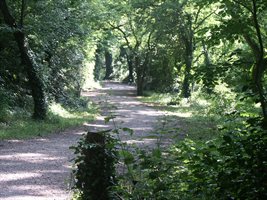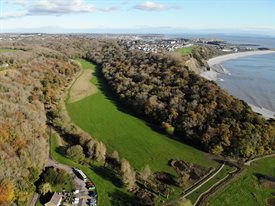Country Parks and Ash Dieback
Ash dieback, also known as Chalara, is a fungal disease that affects all species of ash trees (Fraxinus).
The disease has spread west across the country and is now affecting almost all parts of Wales
 The fungus (Hymenoscyphus fraxineus) attaches itself to the leaves of ash trees and spreads through to the branches, causing the tree to eventually die. There is no known cure or practical way to prevent the disease from spreading. The disease affects ash trees by blocking the water transport systems, causing leaf loss, lesions in the wood and on the bark. This leads to the dieback of the crown of the tree. Trees become brittle over time with branches breaking away from the main body of the tree. If they are not dealt with, then over time, trees are at risk of collapsing, presenting danger to the surrounding area.
The fungus (Hymenoscyphus fraxineus) attaches itself to the leaves of ash trees and spreads through to the branches, causing the tree to eventually die. There is no known cure or practical way to prevent the disease from spreading. The disease affects ash trees by blocking the water transport systems, causing leaf loss, lesions in the wood and on the bark. This leads to the dieback of the crown of the tree. Trees become brittle over time with branches breaking away from the main body of the tree. If they are not dealt with, then over time, trees are at risk of collapsing, presenting danger to the surrounding area.
Ash dieback is a Europe-wide problem and 90% of ash trees are expected to die from the condition. Ash Dieback has major implications for landowners and Councils across the UK who have ash trees on their land. Some rural Council`s in England think as many as 500,000 ash trees on their land have been affected by ash dieback.
How we are tackling ash dieback
 The Countryside team are carrying out a programme of Ash tree inspections within the Country parks to identify how many Ash trees we have and what condition they are in. The surveys will take many months to complete and then we will be re-surveying on an annual basis until the disease has run its course. Over the next few years, ash trees within the Country parks will be assessed to establish how the disease has affected them - and how quickly they need to be felled, by acting now we'll be able to manage the disease in a controlled manner.
The Countryside team are carrying out a programme of Ash tree inspections within the Country parks to identify how many Ash trees we have and what condition they are in. The surveys will take many months to complete and then we will be re-surveying on an annual basis until the disease has run its course. Over the next few years, ash trees within the Country parks will be assessed to establish how the disease has affected them - and how quickly they need to be felled, by acting now we'll be able to manage the disease in a controlled manner.
There are many hundreds of Ash trees within the Country parks and unfortunately the only way to remove the risk posed by badly affected trees is to fell them.
Ash trees affected by ash dieback will be categorised in one of four categories:
Class of tree
| Class 1 |
100% - 75% |
Remaining canopy |
(vitality class 0) |
| Class 2 |
75% - 50% |
Remaining canopy |
(vitality class 1) |
| Class 3 |
50% - 25% |
Remaining canopy |
(vitality class 2) |
| Class 4 |
25% - 0% |
Remaining canopy |
(vitality class 3) |
This will help us determine which trees are in need of removal. Trees in class one are either unaffected by ash dieback or show early signs of the disease. Trees in class four will be heavily affected by the disease with a large amount of leaf loss and brittle branches - these trees will become a priority for removal.
Some Ash trees will hopefully show good levels of resistance to the disease and will not be considered for removal - These trees are very important for the ecological value they retain in the environment and may help re-populate the species in the future. The Countryside team will promote natural regeneration within the Country Park woodlands but where trees have been affected within public areas, such as car parking areas, the team will replace any tree lost to the disease with 2 new trees of a different species.